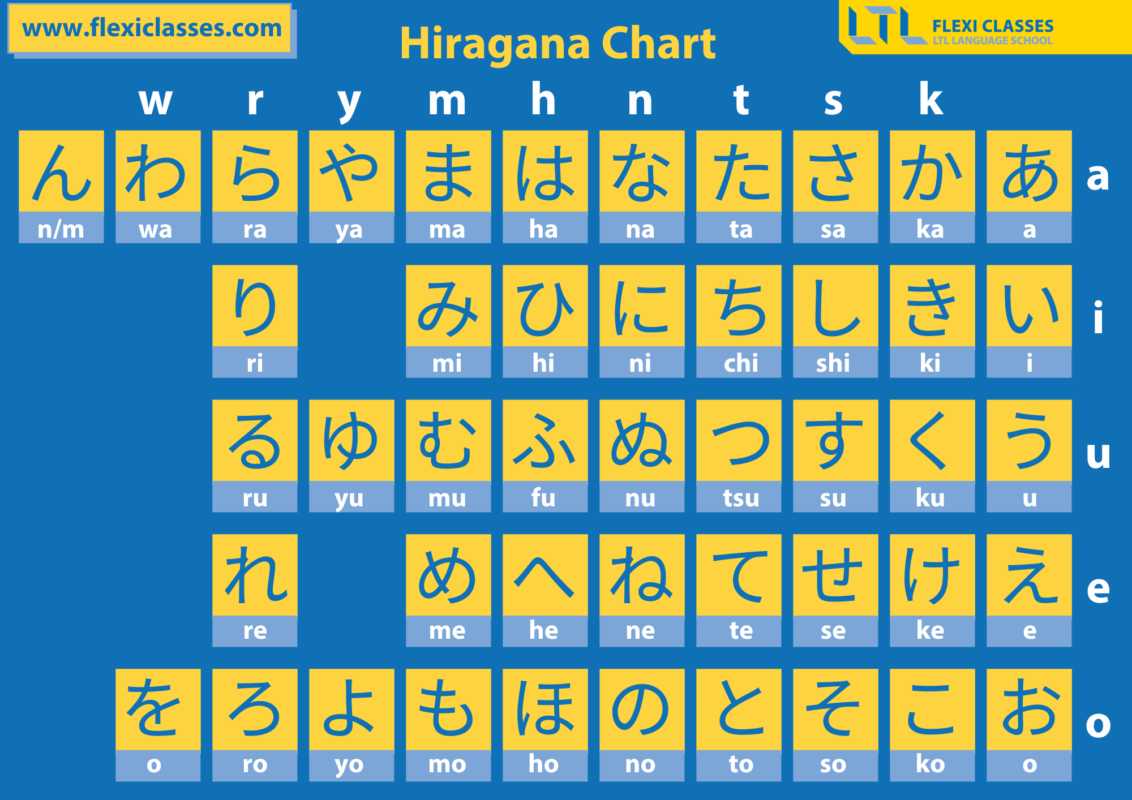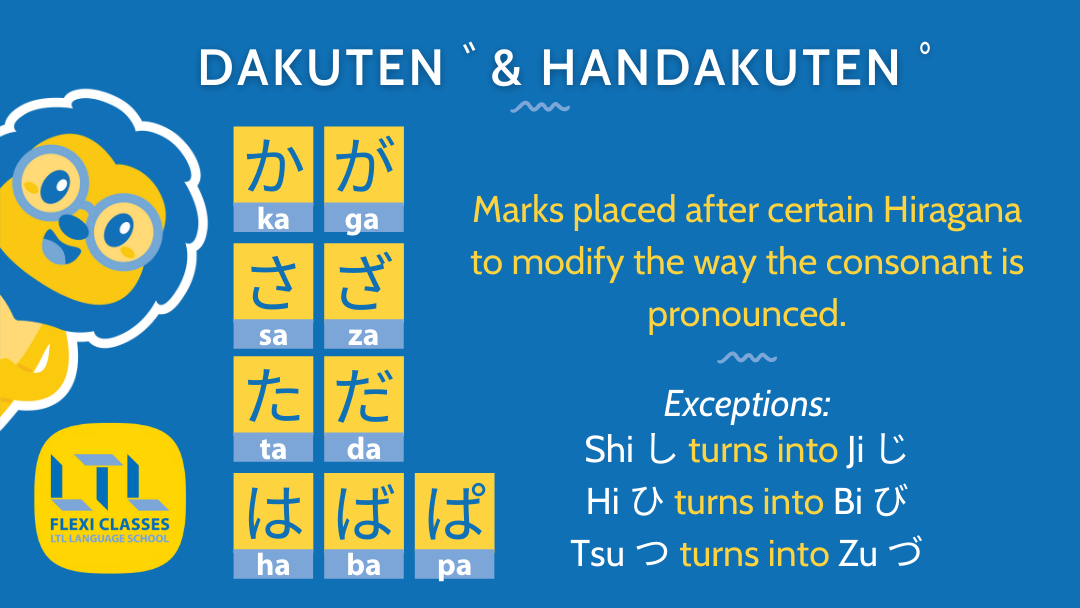Japanese Grammar | Step by Step Guide to Learning Hiragana
You’ve decided to learn a new language, Japanese. That’s great!!
Let’s get you started with this beautiful journey of learning Japanese. As you are aware, learning a new language starts with learning the script.
In Japanese, there are three scripts to learn:
Hiragana, Katakana and Kanji.
Just like in Mandarin, Kanjis are logographic, i.e. each character has its own meaning and corresponds to a word.

A set of 2,136 characters has been officially declared as “Kanji for Everyday Use”.
However unlike Mandarin, Japanese Kanji cannot be used alone. Two additional, syllable-based scripts are used for words without corresponding Kanji and grammatical patterns.
Due to this, Kanji along with Hiragana and Katakana make the Japanese alphabet.
Sounds overwhelming? But no need to worry!
We are here to help you through our course. Hiragana and Katakana, each consist of just 46 syllables. They are easier to learn.
Let us first introduce you to Hiragana.
Learning Hiragana | The ‘A’ Series
Learning Hiragana | The ‘Ka’ Series
Learning Hiragana | The ‘Sa’ Series
Learning Hiragana | The ‘Ta’ Series
Learning Hiragana | The ‘Na’ Series
Learning Hiragana | The ‘Ha’ Series
Learning Hiragana | The ‘Ma’ Series
Learning Hiragana | The ‘Ya’ Series
Learning Hiragana | The ‘Ra’ Series
Learning Hiragana | The Last 3 Syllables
More Syllables | Dakuten, Handakuten, Sokuon & Youon
Japanese Grammar | FAQ’s
Learning Hiragana – The ‘A’ Series
Let’s start with the very first series of syllable:
| Hiragana | Romanisation |
|---|---|
| あ | a |
| い | i |
| う | u |
| え | e |
| お | o |
Now, let’s see some words containing these syllables:
| Hiragana | Romanisation | English |
|---|---|---|
| あい | a-i | Love |
| あおい | aoi | Blue |
| うえ | ue | Above |
| いう | iu | To speak |
| あう | a-u | To meet |
Learning Hiragana – The ‘Ka’ Series
The second series of the Hiragana Alphabet is Ka:
| Hiragana | Romanisation |
|---|---|
| か | ka |
| き | ki |
| く | ku |
| け | ke |
| こ | ko |
Some words including these syllables:
| Hiragana | Romanisation | English |
|---|---|---|
| かく | khaku | To write |
| きく | khiku | To hear |
| け | ke | Fur |
| こ | ko | Child |
| あかい | akai | Red |
NOTE – when a word starts with ‘か’ or ‘き’ it is pronounced as ‘kha’ or ‘khi’ instead of ‘ka’ or ‘ki’ respectively.
Learning Hiragana – The ‘Sa’ Series
| Hiragana | Romanisation |
|---|---|
| さ | sa |
| し | shi |
| す | su |
| せ | se |
| そ | so |
Some examples:
| Hiragana | Romanisation | English |
|---|---|---|
| すし | sushi | Japanese Sushi |
| あさ | asa | Morning |
| あせ | ase | Sweat |
| そこ | soko | There |
Learning Hiragana – The ‘Ta’ Series
| Hiragana | Romanisation |
|---|---|
| た | ta |
| ち | chi |
| つ | tsu |
| て | te |
| と | to |
Some examples:
| Hiragana | Romanisation | English |
|---|---|---|
| たつ | tatsu | To stand |
| いち | ichi | One |
| いつ | itsu | When |
| て | te | Hand |
| とおい | tōi | Far, distant |
Learning Hiragana – The ‘Na’ Series
| Hiragana | Romanisation |
|---|---|
| な | na |
| に | ni |
| ぬ | nu |
| ね | ne |
| の | no |
Some examples:
| Hiragana | Romanisation | English |
|---|---|---|
| なに | nani | What |
| ぬの | nuno | Cloth |
| ねこ | neko | Cat |
Learning Hiragana – The ‘Ha’ Series
| Hiragana | Romanisation |
|---|---|
| は | ha |
| ひ | hi |
| ふ | fu |
| へ | he |
| ほ | ho |
Some examples:
| Hiragana | Romanisation | English |
|---|---|---|
| はな | hana | Flower |
| ひと | hito | Person |
| へた | heta | Unskilful |
| ほか | hoka | Other |
Learning Hiragana – The ‘Ma’ Series
| Hiragana | Romanisation |
|---|---|
| ま | ma |
| み | mi |
| む | mu |
| め | me |
| も | mo |
Some words to practice:
| Hiragana | Romanisation | English |
|---|---|---|
| いま | ima | Now |
| みみ | mimi | Ear |
| むかし | mukashi | Long ago |
| め | me | Eyes |
| もつ | motsu | To hold |
Learning Hiragana – The ‘Ya’ Series
| Hiragana | Romanisation |
|---|---|
| や | ya |
| ゆ | yu |
| よ | yo |
Examples of words including these syllables:
| Hiragana | Romanisation | English |
|---|---|---|
| やま | yama | Mountain |
| よむ | yomu | To read |
| ゆき | yuki | Snow |
Learning Hiragana – The ‘Ra’ Series
| Hiragana | Romanisation |
|---|---|
| ら | ra |
| り | ri |
| る | ru |
| れ | re |
| ろ | ro |
Words including these syllables:
| Hiragana | Romanisation | English |
|---|---|---|
| あらう | arau | To wash |
| ある | aru | To exist |
| れい | rei | Example |
| りか | rika | Science |
The Last 3 Hiragana Syllables
| Hiragana | Romanisation |
|---|---|
| わ | wa |
| を | wo |
| ん | nn |
Examples:
| Hiragana | Romanisation | English |
|---|---|---|
| わたし | watashi | I, Me |
| えをかく | ewokaku | To draw a picture |
| にほん | nihon | Japan |

Additional Syllables
Use of Dakuten
| GA series | ZA series | DA series | BA series |
|---|---|---|---|
| が (ga) | ざ (za) | だ (da) | ば (ba) |
| ぎ (gi) | じ (ji) | ぢ (ji) | び (bi) |
| ぐ(gu) | ず (zu) | づ (zu) | ぶ (bu) |
| げ (ge) | ぜ (ze) | で (de) | べ (be) |
| ご (go) | ぞ (zo) | ど (do) | ぼ (bo) |
Use of Handakuten
Handakuten converts the は (ha) series into ぱ = the ‘Pa’ series.
| ぱ (pa) | ぴ (pi) | ぷ(pu) | ぺ(pe) | ぽ (po) |

Use of Small Alphabet – Sokuon (促音)
The sokuon (促音) is a symbol in the form of a small hiragana or katakana tsu.
In less formal language it is called chiisai tsu (小さいつ) or chiisana tsu (小さなつ), meaning “small tsu“.
It can never appear at the beginning of the word.
The small つ is used to stress the word by doubling the consonant.
For example:
| Hiragana | Romanisation | English |
|---|---|---|
| ゆっくり | yukkuri | Slowly |
| ざっし | zasshi | Magazine |
Other Syllables – Youon (拗音)
The youon (拗音) is a hiragana in combination of a syllable ending in i, such as き (ki), with a smaller version of one of the three y syllables (ya, yu or yo).
や、ゆ and よ are often used in combination with the basic syllables き、し、ち、に、ひ、み and り。
This way a word like しゅみ will not be pronounced as shi-yu-mi, but shyumi.
| Hiragana | Romanisation | English |
|---|---|---|
| ひゃく | hyaku | Hundred |
| いっしょに | isshouni | Together |
| しゅみ | shyumi | Hobby |

Are you a Flexi Classes student already?
Learn more about Hiragana in the following Flexi lessons:
Hiragana (Intro)
More Hiragana (Intro)
Not a Flexi Student yet?
And that’s it! A quick and easy lesson for your to add to your knowledge bank.
Before you go, here’s a list of Japanese blog articles you might find interesting:
Make sure to visit our Japanese Grammar Bank regularly, as we constantly add new lessons to help you learn or review your knowledge.

FREQUENTLY ASKED QUESTIONS
How many Hiragana are there?
There are 46 Hiragana on the Hiragana table to learn, each representing a different sound.
What are the 3 Japanese alphabets?
Japanese has 3 alphabets which each serve different purposes.
They are:
Hiragana
Katakana
Kanji
You can find out more about the 3 Alphabets of Japanese here.
Are Japanese Kanji and Chinese characters the same thing?
Japanese Kanji indeed come from Chinese characters.
Be careful though!
Not only do they not have the same pronunciation, they can also hold different meanings.
Visit this article we wrote about Kanji and Hanzi you shouldn’t confuse!
Where to learn Hiragana?
You can learn Hiragana in our article right here!
Don’t forget to also check out our Top 7 Tips to Learn Hiragana.
The best way to learn the Japanese alphabets, including Hiragana, would be with a native teacher.
Do you offer Japanese classes?
Yes we do!
Check out our online Japanese classes here.
All lessons are taught by professional native teachers.








